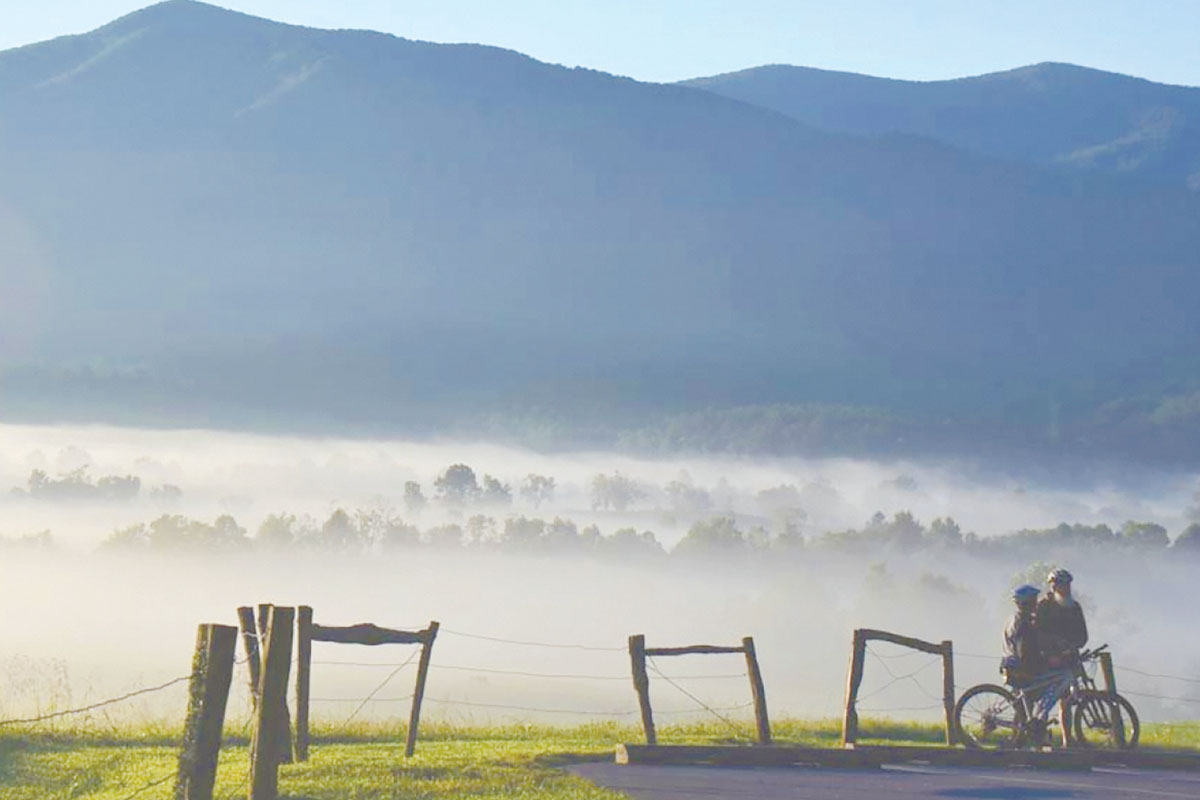Admin
A Blessing of the Animals will be held at 9:30 a.m. on Sunday, Oct. 9, at Grace Episcopal Church in the Mountains in Waynesville. The annual event is held in memory of St. Francis of Assissi. All are welcome to attend with their animal companions, large or small.
In past years, a great variety of pets, and some farm animals have joined the service, including llamas, donkeys, birds, as well as dogs and cats. Small children may bring their stuffed animals.
The service will be held on the lawn of the church. Chairs will be provided, and families may also bring blankets for seating on the ground.
828.648.3173.
To the Editor:
While the good folks at Frontier (Everett, Wash., customer service call center) offered as a good faith gesture to lower my monthly landline phone charge by $11, my original request for an update on DSL service was met with lots of vague responses.
I explained that while Verizon gave extremely token acknowledgement to DSL for those of us who are “rural rurals” we are anxious to get high-speed internet service at our homes. The representative assured me that Frontier IS addressing that issue: service to rural America. But how does that affect us in Jackson, Haywood, Swain and other counties?
Unfortunately, no answer as to the important issue of “when.” Six months? One year?
A decade? “There are a lot of technical matters which have to be resolved by the engineers,” the rep told me. Then I asked the question of why don’t they give customers an updated status as to how progress is being made by the engineers? “We tried to give customers who called that type of information and when they anticipated operational date came and went without the service, there were a lot of irritated customers so we don’t do that anymore,” was the rep’s reply.
“Who can I talk to in this area who can give me an update,” I asked.
The reply was “we do have an office in Sylva.”
“May I please have that number.”
“Sorry, there is no number for that office”.
Wonderful, a communication company that you can’t communicate with locally!
My interest in the subject of DSL at our home came when a contract Frontier workman mentioned that a couple of homes way beyond ours had Frontier DSL and said we should be able to as well. My interest at that point peaked and my wife checked the internet for the Frontier customer service number.
While zip was resolved in my conversation with the gentleman at the customer service call center, I did enjoy the bantering about lack of information available for those hungering for DSL, and of course, the reduction in the monthly Frontier bill.
Frontier should at least have the public relations decency to provide information as to current status of DSL for its “rural rural” customers. Information that gives us a glimmer of hope.
David Redman
Sylva
To the Editor:
I found Rep. Phil Haire’s recent letter outlining and justifying his opposition to SB 514, the Defense of Marriage Bill, very alarming.
Rep. Haire was 100 percent wrong when he said that to put the issue of homosexual marriage on the ballot in the form of a constitutional amendment is a “gross waste of your time and state funds.” Mr. Haire fails to take into account that marriage between one man and one woman is an integral part of the moral foundation that this country and the state of North Carolina is built upon. It is worth fighting for, both from a moral and economic standpoint.
The issue of gay marriage is all about the money, plain and simple. Sure, homosexual couples want to feel that their unions are validated and legitimate, but the bigger issue is to be recognized for the sake of financial reasons (Social Security benefits, state pensions, insurance).
What people do behind closed doors is strictly their own business. However, when that behavior is brought out and forced upon the public and is attempted to be mainstreamed — and paid for by the taxpayers — it must be stopped for the good of our state and our country!
Rep. Haire needs to make clear his stance. He is not against SB514, rather he is for gay/homosexual marriage, plain and simple. Mr. Haire also references several biblical passages which aided his decision making process. Unfortunately, I think he failed to take several verses, which clearly outline what marriage is, into account: “Have ye not read, that he which made them at the beginning made them all male and female. For this reason a man will leave his father and mother and will be united with his wife, and the two will become one flesh” (Matthew 19:4-5).
This is a very serious issue that effects all of us and our future generations. I hope that Rep. Haire will remember that the next time he casts a vote in Raleigh that he thinks will save the taxpayers time and money.
Scott C. Stump
Waynesville
To the Editor:
I’d like to address the letter three weeks ago by my representative to the General Assembly, The Honorable Phil Haire.
Short and to the point, I have two issues. First, it is very telling that our elected representative finds it just too much trouble to answer personal contacts of concern about an issue on a one on one basis and then attempts to do it publicly through a letter to the editor while attempting to invoke scripture to justify his position. If it were an election for his position, he would be the first to reach out and take that hand shake, kiss that baby, and chase that vote while all the time looking for a political donation.
This leads to the even bigger problem I have with Mr. Haire’s position against the Constitutional Amendment “To Define Marriage as being between a Man and a Woman.” Mr. Haire basically declared that, “We the people” should not be allowed to vote on this issue of a constitutional amendment. The content of the amendment is not as relevant to me, but his attitude in standing in judgment of his constituents puts him in the position of a political a fool.
“We the people” are not ignorant and we do not forget those who attempt to limit the power of the vote. I wish him no harm, but then again I have little use for someone who takes such an arrogant stand against the very voters who elected him. I would hope that his replacement will have a better concept of the American way.
John Herrin
Bryson City
To the Editor:
If property revaluation is postponed until 2015, the Macon County Commissioners are again gambling that property values will be comparable to the current valuations in order to maintain the current budget level. Consider that they could be worse than now or even worse than 2013. Using the analogy of a nurse pulling off a band-aid: pull it off quickly and endure the pain for a short period, or pull slowly and endure the pain for a long time.
Also, commissioners cite that if valuations decrease and the millage remains the same, revenues would decrease. This would necessitate a decrease in services. In this economy I have had to decrease the goods and services I purchase. It appears that government spending, healthcare, and inflation are all going up while incomes are going down. That is a good definition of unsustainable. Commissioners should pull the band aid quickly!
Robert Bourke
Franklin
To the Editor:
These questions are directed to progressives, liberals or left-thinking people.
• Why do you think it’s OK for the government to hold a gun to my head and take my money to give to more deserving or “less fortunate” people when, in fact, most of those people simply refuse to take individual responsibility for their own wealth and well-being?
• Why do you think it’s OK for the government to force me to send my kid to a government school that has a failure rate of 75 percent and is allowed to stuff drugs down my kid’s throat simply because some lame teachers don’t know how to teach the gifted, thus turning him into a zombie and drug addict?
• Why do you think it’s OK for the government to steal my property from me, property that has been in my family for over 200 years, and give it to some unnamed, uncaring corporation just because they will pay more taxes on it than I do, then, when they decide not to build on it, the government keeps it and gets zero taxes on it?
• Why do you think it’s OK to let total strangers fondle your 6-year-old daughter or your 80-year-old mother because they just might have a bomb strapped to them, all in the name of security?
• And finally, why do you think it’s OK for the government to continue to trample our Constitution, shredding it every single day in the name of social justice?
Why? Just asking.
Larry Porter
Waynesville
The Oconaluftee Institute for the Cultural Arts is offering evening classes this fall in a variety of disciplines.
• Intro to Printmaking will be offered from 6 to 8:30 p.m. on Oct. 10 and Nov. 14 in Cherokee. Students will get an overview of letterpress printing from Frank Brannon, printmaking instructor. He will demonstrate basic printmaking methods from setting type and inking the press to the actual operation of the press. Participants will have an opportunity to print note cards in the Cherokee Syllabary. Cost is $20 per person.
• Book Arts will happen from 6 to 9 p.m. on Oct. 12, 18 and 19 at the Macon, Swain and Cherokee campuses. Unlock your inner artist through following or altering traditional forms of bookmaking. Learn how to make a simple bound and folded book. Students can bring cutouts from magazines or old books, snippets of ribbon, old letters, buttons or findings from nature such as feathers or pressed flowers. The course is taught by Kathrine Cays and costs $18.
• Intro to Leather Work will teach the art of handmade leather craft from 6 to 9 p.m. on Oct. 11, 13 and 20 in Macon and Swain counties and in Cherokee. Students will learn to work with basic leather working tools to create a change pouch. The class is taught by Kathrine Cays and costs $22.
• Advanced Firing Techniques in Raku ceramics will run from 5 to 10 p.m. from Nov. 8 through Dec. 13 and will focus on raku glazes, applying raku glazes, building a raku kiln, firing, and safety. Taught by Joe Frank McKee, the class costs $120, materials not included.
• Liquid Clay Ceramics will be held from 6 to 9 p.m. Nov. 17 through Dec. 15. Students will learn several liquid clays. Taught by Elsie Delfield, course cost is $65, materials not included.
828.497.3945 or email This email address is being protected from spambots. You need JavaScript enabled to view it..
The Maggie Valley October Leaves Craft Show will be held from 9 a.m. to 5 p.m. on Saturday and Sunday, Oct. 8 and 9, at the Maggie Valley Festival Grounds.
Admission is free and there is plenty of parking for everyone. Artists and crafters will sell their handmade products and some will demonstrate their craft. Festival food will also be available.
828.497.9425 or www.maggievalleycraftshows.com.
The Bryson City Chamber Chili Cook Off will mark its 21st year, on Saturday, Oct. 15, and the Swain County Chamber of Commerce is looking for cookers in all classes: traditional (red), white, and vegetarian.
Cash prizes will be awarded for first, second, and third place and average attendance is over 3,000. Held at Frye Street, adjacent to the Great Smoky Mountains Railroad Depot in downtown Bryson City, the day-long event also offers live local music and crafters.
828.488.3681 or This email address is being protected from spambots. You need JavaScript enabled to view it.
The Church Street Art and Craft Show will fill the streets of downtown Waynesville from 10 a.m. to 5 p.m. on Saturday, Oct. 8. The festival usually attracts more than 20,000 visitors and more than 120 juried artists and crafters and food vendors from throughout the Southeast be on hand.
This year will celebrate the 28th festival, which will will feature craft and quilting demonstrations, a variety of mountain music, dance and international and local foods.
Entertainment includes Whitewater Bluegrass, Balsam Range, Honey Holler, Montreat Pipes and Drums, Southern Appalachian Cloggers, Dixie Darlings, Green Valley Cloggers, Fines Creek Flatfooters, Ashegrove Garland Dancers, Randy Orwig, the Living Statue and Mr. Tom, the Balloon Man.
The show is sponsored by the Downtown Waynesville Association.
The Tuckasegee Terror Tales Tour will run every Thursday, Friday and Saturday in October, starting at 7 p.m. in Whittier.
Boarding of the tour wagon will be at the corner of Whittier School Road and Whittier Depot Street in downtown Whittier and runs every 30 minutes.
The tour is presented by the Storytelling Center Of The Southern Appalachians and proceeds benefit the Preservation of Historical Places in Swain County. The cost is $5.
828.488.5705.
An Oktoberfest will be held at 6 p.m. on Saturday, Oct. 8, at the National Guard Armory in Franklin.
The festival is put on by the Foundation for Angel Medical Center and will benefit the renovations for the Outpatient Medicine Department at the hospital.
There will be a silent auction, an oompah band, contests, food including marinated roast pork, potato pancakes, and other authentic German food and drink. The raffle is a football package, which includes four club seat tickets to the Bucs and Carolina Panthers on Dec. 4, at Tampa Bay, two rooms for two nights at the Westshore Hilton and $500 cash.
Tickets are $50 each or four tickets for $100.
828.349.6887.
Tony Award-winning actor Anthony Crivello will direct the hit play, “Heart What’s In the Heart,” which will run Sept. 30 through Oct. 7, at the Highlands Playhouse. This will be the final production of the Playhouse’s 2011 season.
Anthony Crivello received Broadway’s Tony Award, Chicago’s Jefferson Award, a Carbonelle Award and nominations for two Jefferson Awards, two Canadian Dora Mavor Moore Awards, LA’s Ovation, Drama Critics, Robbie, Garland Awards, and Friends of New York Theater Award. He has starred on Broadway in numerous shows as well as on film and televison.
For tickets for“Hear What’s In the Heart,” call 828.526.2695.
Storyteller and playwright Gary Carden will present a program on Appalachian Jack tales and their origins at 7 p.m. on Tuesday, Oct. 11, at the Jackson County Public Library.
Jack tales are a particular variety of Appalachian folk tale, but their reach extends far beyond our region and stretches far back in time.
“Jack and the Beanstalk” may be the best-known of the Jack tales, but there are variations on many other familiar tales, including Cinderella and Snow White. As far back as any English-language folktale can be traced, there are stories about Jack, often a trickster or sometimes just a simple, shy boy, or even a mute.
So what makes a story a Jack tale? Carden will explore these questions and the many origins of Jack tales, from the Brother Grimm to Shakespeare, and in the process will tell a few of his favorite tales.
Carden, who lives in Sylva, is an award-winning storyteller, author, screenwriter and playwright. He is the founder of The Liar’s Bench, a popular live variety show featuring storytelling, music, and poetry.
828.586.2016.
The Haywood County bluegrass group Balsam Range won the International Bluegrass Music Association’s Song of the Year award for 2011 for “Trains I Missed.”
The awards were handed out Sept. 29 at the Ryman Theater in Nashville.
“Trains I Missed” is the title track of the album of the same name. According to the groups website, the song — written by Walt Wilkins, Gilles Godard, and Nicole Witt — “is a ballad about things not done in life, that leads you straight to what was supposed to be. ‘Trains I Missed’ is one of those songs that helps define a moment in one’s life, as well as in one’s career.”
To listen to a snippet of the song, log onto the group’s website at http://balsamrange.com/shop/trains-i-missed/.
Band member Darren Nicholson put a post on the group’s website on Oct. 1: “Wow … we can’t believe it! What huge honor. We sure appreciate all the great comments. We always try to respond to everyone but it may take us a while. Thank you. Thanks for all the kind words and support you given this band and our music. Thanks for believing in us and this incredible song. We sure did from the first time we heard it. We feel privileged and so lucky to have snagged such a great song. Thanks to the songwriters. We we’re so happy that two of them (Nicole and Walt) were there with us Thursday to share in the celebration.”
Balsam Range is: Tim Surrett plays bass, occasional resonator guitar, and sings lead and harmony; Buddy Melton sings in a powerful tenor and plays fiddle; Caleb Smith has been called “one of the top young guns of guitar” and is also known for his energetic power singing; Darren Nicholson plays mandolins and sings harmony; and Marc Pruett plays traditional three finger banjo.
Balsam Range will play this Saturday, Oct. 8, at the Church Street Arts Festival in downtown Waynesville.
Also winning an IBMA award for Entertainer of the Year was the Brevard-based Steep Canyon Rangers. The group includes film star Steve Martin on banjo.
Sing for the Fun of It, a songfest featuring old familiar favorites, will start at 7 p.m. on Oct. 11 at The Macon County Public Library.
Included in the repertoire will be songs like “Blue Skies,” “Down In the Valley,” “Home On the Range,” “My Bonnie,” “Oh! Susanna,” “You Are My Sunshine,” and many more, with a song leader and guitar accompanist. Song sheets will be provided and attendees are encouraged to bring a favorite song for the group to enjoy.
828.524.7683.
Grammy-nominated bluegrass musicians the Grascals will perform at 3 p.m. Sunday, Oct. 9, at Western Carolina University’s John W. Bardo Fine and Performing Arts Center.
The show, “Dance Til Your Stockings Are Hot and Ravelin,’” is a musical tribute to 1960s sitcom “The Andy Griffith Show.” Since the band’s formation in 2004, the Grascals have received honors and awards throughout the musical community. The Grascals earned four 2011 International Bluegrass Music Assocation nominations, including Entertainer of the Year and Song of the Year for their single “I Am Strong” with Dolly Parton. They also earned Grammy Award nominations in 2006 and 2007.
Impersonator David Browning will perform his improvisational show “The Mayberry Deputy” as the opening act.
Tickets are $20 for adults and seniors, $15 for WCU faculty and staff, $10 for groups of 20 or more and $5 for students and children.
828.227.2479 or bardoartscenter.wcu.edu.
Open Mic nights are returning this fall from 7 to 9 p.m. on the first Thursday of each month at Blue Ridge Books on Main Street in Waynesville. The October-to-May series is hosted by local musician and songwriter, Chris Minick, and sponsored by The Haywood County Arts Council and the Music and Poetry Lover’s Network. The new season begins Thursday, Oct. 6, and runs through May 3.
Open Mic nights are free and open to the public. Attendees will have the opportunity to make a donation to benefit the Arts Council’s JAM (Junior Appalachian Musicians) after school program. Participants may begin signing up for sets at 6:45 p.m.
828.452.0593 or 828.456.6000.
Celtic Thunder, a singing group from Ireland, will perform 7:30 p.m. on Saturday, Oct. 8, at Harrah’s Cherokee Hotel and Casino. The group has five male soloists who perform both independently and collectively. They debuted in August 2007 and have since become a household name, releasing six albums expanding into over 40 countries.
800.745.3000 or www.ticketmaster.com. Must be 21 or older to attend.
Dailey & Vincent, an award-winning bluegrass band, will perform at 7:30 p.m. on Oct. 7, at the Smoky Mountain Center for the Performing Arts in Franklin. Tickets start at $12.
Jamie Dailey and Darrin Vincent are the front men of the group. Dailey plays guitar and bass and sings lead and harmony vocals. He began his career as a member of the highly acclaimed band, Doyle Lawson & Quicksilver, and has recorded with such greats as Dolly Parton and Rhonda Vincent.
Darrin Vincent plays mandolin, bass, and guitar and sings lead and harmony vocals. His career began at a very young age when he started performing with his family band, The Sally Mountain Show, alongside his sister, Rhonda Vincent. He won five Grammy awards as a member of Ricky Skaggs and Kentucky Thunder and has received many other awards as well.
Tickets start at $12.
866.273.4615 or visit www.greatmountainmusic.com.
Jammin’ at the Millpond will be held from 10 a.m. to dusk on Saturday, Oct. 8, on the Haywood Community College campus. This is a free bluegrass event to showcase the college, its programs and alumni, and the Appalachian heritage of Western North Carolina.
The music will be hosted by the Hominy Valley Boys, emceed by Richard Hurley, and feature other local artists and clogging teams. Some of the performers include First Time Out, Merrie Belle Clark & Family, HCC Wildlife Band, Reems Creek Incident, Jonathan Creek Cloggers, Fines Creek Flatfooters and Smoky Mountain Stompers. Jonathan Creek Cloggers will conduct a demonstration workshop at 2 p.m.
The day-long festivities will feature a molasses making demonstration with samples, barbeque meals available for purchase, alumni gathering tent, student club booths, car show, HCC Woodsmen’s Team demonstration at 3 and 5 p.m., corn shelling, corn milling, 1840s reenactment and much more. There will also be Re/Max tethered hot air balloon rides, wind and weather permitting, from about 5:30 p.m. until dark.
828.627.4522 or This email address is being protected from spambots. You need JavaScript enabled to view it..
Watercolor artist Ann Vasilik will present at the next meeting of the Blue Ridge Watermedia Society, from 6:45 to 9 p.m. on Oct. 11, at Haywood Community College Bldg 1400. She will be painting a town scene from Colonia del Sacramento, Uruguay.
The tri-venue Cashiers Valley Leaf Festival will run from Oct. 7-9, in the three festival villages: Cashiers, Glenville and Sapphire.
The festival will feature entertainment by bands of several musical genres, artisan crafts, vendor booths, food and kid-attracting activities.
Each of the three villages brings their own character to the festival while businesses and shops throughout the Cashiers Valley welcome festival-goers, visitors and local residents with shop and roadside décor. Many compete in the “Scarecrow Contest” where judges will select the best scarecrow of all prior to the festival.
The main venue, the Cashiers Village Green and Commons, located at the Cashiers crossroads, is festival headquarters. Here music and performance-lovers can enjoy all-day theatrics and diverse music entertainment on two stages. Booths will showcase juried artisans and a variety of vendors. The food court will offer fare from local restaurants and a spot to relax and observe all the goings-on. Merchants throughout the Cashiers Village will also feature sales and specials all weekend in their shops. Kids with excess energy, needing active time, can play at the permanent Village Green playground and for quieter time visit the kids craft tent to create their own tribute to fall.
Glenville Village, about five miles north of Cashiers Village on the shores of Lake Glenville, will offer more folksy fare in a local artist tent highlighting area crafters and artists ranging from potters to woodworkers. Here, hungry festival goers can sample apples, cider and hot dogs with trimmings while listening to bluegrass, banjo and a bit of gospel entertainment. There will also be the chance to pick a pumpkin from the pumpkin patch, visit a Christmas tree farm for a pancake breakfast or cruise Lake Glenville on a pontoon boat to view Lake Glenville.
Moving east from the Cashiers Crossroads on U.S. 64, attendees will find shops and eateries at Sapphire Village. Sapphire is the home of the Festival’s Big Cup Golf Tournament on October 8. Prizes for tournament winners include beach resort stays and choices from many local merchants and restaurants.
828.743.5858, 828.743.1630, email This email address is being protected from spambots. You need JavaScript enabled to view it. or visit www.cashiersvalleyleaffest.com.
Painter Steve Penley will give a free talk about his art, his life, his faith and experiences at 7 p.m. on Oct. 7, at the Fine and Performing Arts Center at Western Carolina University. With subjects such as Winston Churchill, Abraham Lincoln, Jimmy Hendrix, Ford Trucks, Coca-Cola bottles, Mona Lisa, flower vases, horse races and The 34 Most Memorable Plays in Georgia Football History, Penley has a wide variety of subjects that he captures in a unique and recognizable style.
He will also complete a demonstration painting for onlookers. There is a free reception beforehand at 6:30 p.m. and Penley will be available to talk and sign posters afterward.
847.732.0221.
There will be a free screening of “Mars,” a romantic comedy that follows three astronauts on the first manned mission to Mars, at 7:30 p.m. on Tuesday, Oct. 11, in the theater of the University Center at Western Carolina University.
With a veneer of silliness, the film also is a deeper look into the nature of exploration. Writer and director Geoff Marslett will be on hand immediately after the screening to discuss the film with the audience. Marslett has won several industry awards for “Mars,” his first full-length film.
The screening is part of the Southern Circuit film tour.
828.227.3622, email This email address is being protected from spambots. You need JavaScript enabled to view it. or visit ace.wcu.edu.
Angie Toomey and Friends will present a variety show to benefit the Make-A-Wish Foundation at 7 p.m. on Saturday, Oct. 8, at Stuart Auditorium at Lake Junaluska. The show will help grant wishes to children with terminal and long-term illnesses in Central and Western North Carolina.
The cast of entertainers this year includes Arkansas Rose, Betty Natzke, Crimson Road, Keith Smith, Julia Ann Roberts, Leslie Hipps, Music Works Dancers, Paul Indelicato, the Rye Holler Boys, Tina Mathis, the West & Central African Drum Group and Angie Toomey. The Fines Creek Flatfooters will also perform.
Tickets are $25. 828.452.2881.
A meeting to organize the Smoky Mountain Paddling Club will be held at the meeting room in United Community Bank at 1640 East Main Street in Sylva at 6:30 pm. on Thursday, Oct. 6.
Paddlers of all ages and levels of experience interested in kayaking, canoeing or stand-up paddle-boarding on flatwater or whitewater are invited to attend.
Pizza and drinks will be provided courtesy of Duke Energy.
Students in a Western Carolina University parks and recreation management course are helping coordinate the event.
252.558.5122 or This email address is being protected from spambots. You need JavaScript enabled to view it..
Celebrate the heritage of Western North Carolina during the annual Forest Festival Day on Saturday, Oct. 1 from 9 a.m. to 5 p.m. This is the Cradle of Forestry’s largest event of the year.
This event commemorates the traditions of mountain living and craft in a unique and beautiful setting. More than 30 traditional craftsmen, exhibitors, and musicians will line two paved trails at the Cradle of Forestry to help celebrate. During the event, five colleges will compete for a trophy in the 16th Annual John G. Palmer Intercollegiate Woodsmen’s Meet, organized by Haywood Community College. STIHL is the presenting sponsor of the festival.
At the corral along the Biltmore Campus Trail, festival-goers can cheer as college forestry students compete during the Woodsmen’s Meet that has the flavor of an old-time lumberjack competition. Students from Haywood Community College, Penn State Mont Alto, Montgomery Community College, Virginia Tech, and North Carolina State University will test their skills in a number of events including archery, axe throwing, crosscut sawing and pole climbing. If you plan on spending a couple of hours at the Woodsmen’s Meet, you may want to bring a chair or blanket to sit on.
Also along the Biltmore Campus Trail, visitors can see traditional crafts demonstrated including weaving, open hearth cooking, blacksmithing, and creating corn husk dolls. Wash clothes the old way at the wash place. Learn about efforts to restore our native chestnut tree from The American Chestnut Foundation.
Live music in the amphitheatre features QuarterHouse bluegrass band at 11:45 a.m., followed by a music program for all ages, Songs of Forest Folk, until 1:30 p.m. The music continues with roving musicians around the trails. Food will be available for purchase during the event.
The Cradle of Forestry is located four miles south of Parkway Milepost 412 on U.S. 276 in the Pisgah National Forest, six miles north of Looking Glass Falls.
The Summit Charter School’s eighth-grade class tested seven water sources commonly used by hikers along the Appalachian Trail in Macon County.
Testing took place during the group’s annual overnight field trip to the Standing Indian area earlier this month. The collected water data (dissolved oxygen, pH and turbidity) was uploaded to the World Water Monitoring website. Janis Brannon, the science teacher from Summit School and a graduate of the Appalachian Trail Conservancy’s Trail to Every Classroom Program, has planned and executed this field trip for the past five years. The local Nantahala Hiking Club provided hike leaders to lead the students on the hike and to the water sources. The field trip was funded through the state’s AT license plate program.
Delayed-harvest trout water rules on 15 Western North Carolina counties start Oct. 1, replacing a different set of regulations on these streams.
Under delayed-harvest regulations, no trout can be harvested from these waters between Oct. 1 and one half-hour after sunset on June 1. No natural bait is allowed, and anglers can fish only with single-hook, artificial lures. An artificial lure is defined as a fishing lure that neither contains nor has been treated with any substance that attracts fish by the sense of taste or smell.
Both resident and nonresident anglers can fish in designated Mountain Heritage Trout Waters with a three-day, $5 Mountain Heritage Trout Waters license, or with any license that provides trout fishing privileges.
These are the delayed-harvest trout waters in our area:
• Haywood County — West Fork Pigeon River (Queen Creek to the first game land boundary upstream of Lake Logan).
• Henderson County — North Fork Mills River (game land portion below the Hendersonville watershed dam).
• Jackson County — Tuckasegee River (downstream N.C. 107 bridge to the falls located 275 yards upstream of the U.S. 23/441 bridge, marked by a sign on each bank).
• Macon County — Nantahala River (Whiteoak Creek to Nantahala hydropower discharge canal).
• Madison County — Big Laurel Creek (N.C. 208 bridge to the U.S. 25/70 bridge); Shelton Laurel Creek (N.C. 208 bridge at Belva to the confluence with Big Laurel Creek); Spring Creek (N.C. 209 bridge at Hot Springs city limits to iron bridge at end of Andrews Avenue also classified as Mountain Heritage Trout Waters, refer to the commission’s Regulations Digest for additional information).
• Transylvania County — East Fork French Broad River (Glady Fork to French Broad River); Little River (confluence of Lake Dense to 100 yards downstream of Hooker Falls).
Time to swap those seeds, plants and bulbs at the annual Jackson County Farmers Market exchange scheduled for 9 a.m. until noon Oct. 1 in downtown Sylva. Additionally, starting that same Saturday, an exciting new children’s program starts for the remainder of the season.
First, about the seeds: Bring seed that you have saved from non-hybrid vegetables or flowers, or garlic and bulbs for fall planting, as well as perennial plants that need to be divided and replanted in the fall. Seeds, plants and bulbs should be labeled. In the case of flowers, it is helpful to give the color and height of the parent plant. Plants that come up year after year in our gardens are proving that they are adapted to the local climate and can thrive in spite of insect pests.
Now, about those kids: The Fine Arts Museum at Western Carolina University is providing Homegrown FAM (Family Art at the Market). It is providing, free of charge, hands-on arts activity for children every week. Activities take place under the pavilion from 10 a.m. until noon.
828.631.3033.
A guided bird walk sponsored by the Land Trust for the Little Tennessee is set for Friday, Sept. 30, near Tilley Creek in Cullowhee.
The bird walk will be led by Jeremy Hyman, an assistant professor of biology at Western Carolina University teaching classes in ornithology and animal behaviors. Hyman has been an avid birder since childhood and has several publications on bird behaviors. This walk also should be an excellent time to view the fall leaves.
Meet at the entrance of the Jackson County Recreational Park in Cullowhee at 8:30 a.m., to carpool to the location, which is two miles away. The outing will last approximately two hours. Participants should bring water and binoculars. No dogs allowed. For directions and to RSVP, contact Jill Wiggins at This email address is being protected from spambots. You need JavaScript enabled to view it. or 828.524.2711, ext. 209.
For the second year in a row, sixth-grade students from Macon County will find themselves galloping through goldenrod to catch, tag, and release Monarch butterflies as part of “Migration Celebration,” a field trip designed to engage students in real science concerning bird and butterfly migration.
The event will take place through Oct. 4 at Tessentee Bottomland Preserve, a tract of land owned and managed by the Land Trust for the Little Tennessee. The Coweeta Long Term Ecological Research will coordinate the program as part of their “Schoolyard” outreach and education initiative. Students will also learn about migrating songbirds from the non-profit Southern Appalachian Raptor Research, which uses Tessentee Bottomland Preserve as a long-term research site to better understand the rates of survivorship and productivity in bird populations.
Tessentee Bottomland Preserve is a stop on the N.C. Birding Trail with 125 species of birds located within its 70-acre boundary. Biologists will use mist nets to catch, band, and release migrating songbirds, giving students an opportunity to see birds up-close.
Students will wield their own nets to try and catch Monarch butterflies as they fly south to over-winter in the Transvolcanic Mountains of Mexico. Once caught, students will learn to carefully take the butterfly out of the net, determine whether the Monarch is a male or a female based on the wing pattern, and place a small sticker on the hind wing with a phone number and unique identification tag.
Data collected by the students will be sent to MonarchWatch (www.monarchwatch.org), the organization overseeing the project. The butterfly will then be released to continue its journey south. Students will also catch, identify, and release other butterflies to help with an inventory of butterflies at the preserve. To date more than 45 species of butterflies have been found, including several new to mountain and county records.
“Two Special Rocks,” a program on how Looking Glass and John Rock were formed, will be held on Oct. 1 from 10 a.m. to noon at the Pisgah Center for Wildlife Education.
The program will discuss what the rocks are made of and what plants and wildlife call these special environments home. This program, which is free and open to ages 8 and older, provides an introduction to the geology and associated plants and wildlife in the area. Space is limited; pre-registration is required.
828.877.4423 or www.ncwildlife.org/Education_Workshops/Pisgah_Center.htm.
The Pisgah Center for Wildlife Education is located near Brevard on the Davidson River. The center is adjacent to the N.C. Wildlife Commission’s Bobby N. Setzer Fish Hatchery.
A celebration of a new piece of the Overmountain Victory National Historic Trail will be held at 3 p.m. on Thursday, Sept. 29, at the Hefner Gap Overlook at milepost 326 on the Blue Ridge Parkway.
The Overmountain Trail preserves and commemorates the route used by patriot militia in the 1780 campaign that led to victory over loyalist forces led by Maj. Patrick Ferguson at the key battle of Kings Mountain. Working with a variety of partners, the National Park Service continues to identify trail segments and open them up for public use. The newly opened 1.3-mile section of pathway is actually an original part of the route and is a roadbed that is centuries old.
On Sept. 29, 1780, this section of historic roadway saw the passage of hundreds of patriot militia on horseback heading east through Hefner Gap and toward North Cove. Led by Colonels John Sevier and Issac Shelby, these Overmountain men had come from frontier settlements in present day east Tennessee some days previously. They would play a key role in the victory at Kings Mountain on Oct. 7, 1780.
In 2008, the Conservation Trust for North Carolina was able to purchase the 534-acre Rose Creek tract, preserving land that borders the Blue Ridge Parkway as well as containing the newly certified segment. In April of this year, the land was conveyed to the state Wildlife Resources Commission.
The event is free and open to the public. Members of the Overmountain Victory Trail Association in period colonial dress will participate.
In the event of inclement weather, the program will be held at the nearby covered pavilion at the Historic Orchard at Altapass, located at Parkway milepost 328.3.
828.765.1228.
Haywood Community College students are learning best management practices to reduce stormwater runoff by using the campus itself as laboratory, hoping to restore natural hydrology wherever possible as the campus grows and changes.
Preston Jacobsen, a sustainability analyst, said the campus has had a negative effect on Jones Cove Creek, which is the recipient of runoff from parking lots and other campus facilities. Sophomore students in the LID curriculum — which currently has en enrollment of 17 students — are using bioretention ponds and native plant research as part of their graduation project.
In the long run, the plan is for the project to mitigate the impact of development on the campus’s natural hydrology and native plant communities. Jacobsen said students will establish a “test meadow” of native grasses on a campus construction site to serve as a demonstration for converting lawn or forest to meadow, reducing landscaping maintenance needs and creating wildlife habitats on campus.
Jacobsen applied for and received a Greenforce Initiative Innovation Mini-Grant to help fund the project. HCC is one of only five community colleges in North Carolina to receive the grant. The Greenforce Initiative wants to create green career pathways leading to postsecondary credentials and family sustaining careers; increase access and success for lower-skilled adults; and use campus “greening” or sustainability efforts as “learning laboratories” for education and training.
Jacobsen said the grant is not driving the project at HCC, but that part of his job is seek out ways to bring money and investments to the college that will funnel back to students.
“Part of my responsibility is to enhance our instruction, so finding funds via grants or for our instructions to get professional development, the end goal is that it all that funnels back to what our students learn,” said Jacobsen.
The co-mingling of classroom learning and on-campus sustainability is part of HCC’s mission, said Jacobsen.
“Our overarching theme here is to have a living laboratory. If we can give students hands-on experience, whether in a lab or with a physical project on campus, this is part of that mission set forth by (HCC President) Dr. Rose Johnson,” he said.
“We’re working with the Fish and Wildlife program to research native plants to see which will propagate best here, and then apply what we learn to our bioretention cells,” said Jacobsen.
HCC has become a leader in green initiatives and is the only community college in North Carolina that offers a degree in low-impact development major.
“We face a major challenge to retool and rebuild our workforce and meet the challenges of the future clean energy economy,” said Lisa Madry, Campus Field Director for the National Wildlife Federation. “The Greenforce Initiative will help accelerate America’s ability to tackle the climate crisis while creating economic opportunities and pathways out of poverty.”
“Students will earn real world experience through design, implementation and environmental monitoring of the funded project,” said Jacobsen. “All the while, they’ll be improving our campus through the restoration of native plant communities and enhancement of natural hydrology.”
The next teen friends of the library meeting will be held at the Marianna Black Library at 3:30 on Thursday, Sept. 29.
Teens are invited to come share their ideas about materials of interest to them, including what sort of programming they’d like to see at the library. There will be snacks, crafts, games and much more at the meeting. Teen volunteers will be needed for the upcoming Christmas Parade float and don’t forget that teens can earn community service hours for school by volunteering at the library.
828.488.3030.
Author and culture historian Julia Taylor Ebel will give a reading and wreath-making demonstration at 2 p.m. on Saturday, Oct. 1, at City Lights Bookstore in Sylva. Ebel will be reading from her newest book, Mama’s Wreaths.
A series of narrative poems tell the story of Joanie, a young mountain girl who wishes to learn to make wreaths as lovely as Mama’s. Joanie learns not only about the process of wreath making but also of the importance of passing on one’s heritage.
828.586.9499 or email This email address is being protected from spambots. You need JavaScript enabled to view it..
To the Editor:
Wildflower is back, and a lot of people are worried, especially here in the northern part of Macon County. From the time the first developer spoke to a crowd of over 200 at Cowee School and said, “You people will need to upgrade your community for my clientele,” and “You people (how could the man think that was an acceptable way to address the people whose community he was moving into?) are going to need affordable housing…” the thing has not set well on our minds. Then came the flood of sediment into streams, trout ponds and the river as the steep roads were gouged out. People were buying lots sight unseen on the internet, because real estate was hot and was only going to get hotter.
Then came the crash — with foreclosures, lawsuits, damage to our local financial institutions — and to the reputation of Macon County. The lots sat empty, the roads began to crumble, big rains brought on the landslides, the weeds grew up.
But a lot of us didn’t forget, and we wanted protection in the future.
We worked hard to get sensible slope development regulation—but it didn’t happen. Now, the lots are back on the sale block. What are the “fire sale” prices going to do to the real estate comps, and the hopes of other landowners and realtors to sell a piece of land at a fair price? What assurance do we have that the development will be done well this time? What control do we have? Do the people looking at lots up there have any idea about the North Carolina Geological Survey Slope Movement Hazard Maps? Do they know there are unstable soils up there? Down here in the valley, we know it.
But perhaps something a little bit good can come out of this. Perhaps we can put aside the name calling, the politics, the special interest protection, and the shortsightedness and plan for a better situation in the near future. We can put in place slope development regulation that will make sure that the guys who do a good job don’t get undercut by the cheap shortcuts of the careless and uncaring. We can protect the interests of the home builder, the downslope and upslope neighbors, and our precious mountain environment.
Because this is only phase one of the planned project. There are still hundreds of acres to go up there.
Susan Ervin
Franklin
To the Editor:
In the ongoing debate about job creation, much misinformation is being bandied about in an effort to confuse us and advance a conservative agenda.
Some try to convince us that economic growth will generate jobs. But the fact is that the gross domestic product has grown for seven consecutive quarters since the official end of the recession in the second quarter of 2009. However, there has been no increase in jobs during this period. Economic growth has not generated jobs.
Some say there are plenty of traditional jobs if you just look for them. People are unemployed because they’re too lazy to go out and seek work. But the fact is that in May 2011 there were 4.7 unemployed people for every one job opening. That number has not gone below 4.3 in 29 months, while from 2001 through 2008 it never went above 3. This shows that the jobs just aren’t there to look for.
Some claim that if we cut taxes on big corporations and the wealthy, they’ll use the extra cash to create jobs. But the fact is that corporations are sitting on more than $80 billion, and big banks are holding $2.6 trillion that they’re not lending. They aren’t using the reserves they already have to create jobs, so do we really think that if they had more money from tax breaks they would suddenly have a change of heart?
Some argue that proposed new free trade agreements with Korea, Panama, and Colombia will produce economic growth and create jobs. But the fact is that the effect of NAFTA and other free trade treaties already in force has been to shift thousands of American jobs to Mexico and other developing countries. Why would we believe empty promises of jobs when the actual results have been just the opposite?
The claims are belied by the facts. Which will we believe?
Doug Wingeier
Waynesville
To the Editor:
After recently returning to North Carolina from three years in the Southwest, I am saddened to learn that our state legislature is so focused on creating a constitutional amendment banning same sex marriage — yet another piece of divisive legislation that mirrors the current political dysfunction in Washington, D.C.
One could only hope that in these “hard times” our legislators focus on the very real economic issues that many people are dealing with — as if a symbolic defense of traditional marriage will shed light on the current struggle to provide for our families.
I recommend these legislators spend a season in the wilderness, perhaps in the spirit of the desert fathers, to cleanse their souls of such self-serving claptrap.
Roger Turner
Sylva
To the Editor:
The North Carolina Geological Survey landslide hazard map prepared for Macon County is a valuable resource for our county planners, citizens and property owners. The considerable cost developing this resource has been borne by the taxpayers of North Carolina. The Macon County Planning Board has spent extensive time and effort reviewing the information and discussing how it could be used.
The development of this map utilizes considerable fieldwork and data collection on the ground by North Carolina Geological Survey geologists with over 60 days “on-the-ground effort.” More than 600 locations were investigated in that aspect of the study. Serial aerial orthophotography reviewing studies from the years 1954, 1953, 1998, 2005 were included in this investigation. Light detecting and ranging digital elevation data (LiDAR) were utilized to develop a base map for data to be embedded upon. This combination is the best available mapping technology.
Stability Index Mapping information is useful in showing where landslides and the resulting debris flow would more likely occur. Data from existing soil survey maps of the Macon County were also utilized to calibrate Stability Index Maps according to where slope disturbances have already happened in the past. It took more than $500,000 in taxpayer funding and nearly a year to accomplish this project.
With the considerable funding, work and effort used to develop these maps, it would be a shame not to utilize them in a useful manner. It appears that our county has decided to shelve this study. That sounds very much like big government at the federal level instead of a common sense approach that our county officials could represent.
Tom Harris
Franklin
To the Editor,
Rep. Phil Haire’s recnt letter contains the pathetic non sequitur: “to place (the Defense of Marriage Bill) on the ballot in the form of a constitutional amendment is a gross waste of your time and state funds. This is especially true when the papers have articles everyday reporting the loss of state and local jobs.”
Can he possibly explain the correlation between jobs and the sanctity of marriage? If this is a typical example of Haire’s reasoning, we are wasting time and funds on him.
His assertion that the “sole” purpose of the amendment was to “incite political passion and further lead to more societal division” shows his ignorance of history or a deliberate effort to deceive. The Founding Fathers, as well as Lincoln v Douglas and innumerable others, incited political passions to a degree that is exponential in comparison to Haire’s repugnant claim.
Claiming that current statutes legislating marriage are protection enough is absurd. NCGS 51-3.1 banned interracial marriages and was reversed. GS 51-1.1 could as easily be overturned.
Haire tries to justify his position by taking Bible verses containing “love thy neighbor” out of context.
Other Biblical texts are relevant. Jesus explains that it is God, not man who institutes marriage: “Wherefore they are no more twain, but one flesh. What therefore God hath joined together, let not man put asunder.”
When I encounter such Haire-brained and puerile thought, it makes me want to shave my head. Join me. I don’t need Haire, and neither do you.
Timothy A. Van Eck
Whittier
Fortunate Sons, a group of 18 active duty Marines, is planning to collectively hike the entire 1,000-mile North Carolina Mountains-to-Sea Trail in the name of both charity and awareness.
Their 42-day journey begins on Oct. 2 at Clingman’s Dome in the Great Smoky Mountains and ends at Jockey’s Ridge on the outer banks on Veteran’s Day weekend, Nov. 13. All funds raised in support of the event will go directly to the Semper Fi Fund.
The Semper Fi Fund is a non-profit organization that provides assistance to wounded and injured Marines, as well as personnel who might have been wounded or injured while supporting Marines.
“The mission and goals of the Semper Fi Fund are similar to ours,” said Mark Greenlief, a Fortunate Sons member. “Our goals are to show honor and continued support for Marines who were hurt in the defense of our country, who are the reminder of the cost of freedom.”
Jeremiah Johnson recalls how the idea got started.
“I work with a great group of guys and we are always trying to find adventures and something exciting to do in our spare time. We came up with the idea to hike the MST and the wheels started turning from there.”
Although the Semper Fi Fund is the main focus of the efforts being made, Fortunate Sons also plans to raise awareness for the Mountains-to-Sea Trail.
“North Carolina is a beautiful state and what better way to experience its beauty than by hiking its premier trail and meeting people along the way,” explains Johnson. “In my opinion, North Carolina is the most military-friendly state in the Union, and we hope to show our gratitude for the appreciation displayed by both the state’s citizens and its government through raising awareness of the Mountains –to-Sea Trail and the communities that support it.”
The 18 Marines participating on the trail have divided themselves into six two-man teams, with six Marines in reserve. The first team will start at Clingman’s Dome and hike for seven days and then be relieved by the oncoming team.
“Each team will be expected to hike an average of 150 miles a week or roughly 22 miles a day; not exactly an easy task,” says Johnson.
Donations to the cause can be made through the Semper Fi fund at https://semperfifund.org/donate/. Please select “Fortunate Sons” as the event name under Additional Information in the payment form.
For more information about Fortunate Sons, visit www.fortunatesons.org.
Cullowhee Kids Preschool is hosting a reunion for all alumni and current students of the preschool program on Oct. 28.
If you attended Cullowhee Kids Preschool at any time, call 828.293.9215 or email This email address is being protected from spambots. You need JavaScript enabled to view it. and give the name of child, years of attendance, current mailing address, email address and phone number. A formal invitation to the event will be sent later this month.
Enjoy a good meal and benefit a good cause Oct. 3 at 6:30 p.m. at Bourbon Barrel Beef & Ale Restaurant, located at 454 Hazelwood Avenue.
Tickets, sold in advance, are $50 each. The benefit dinner is for REACH of Haywood, which works with victims of domestic violence and sexual assault.
The meal includes salad, dinner with choice of steak, chicken or fish, dessert, tea or water.
828.456.7898.
In recognition of Domestic Violence Awareness Month, R.E.A.C.H. of Macon County is sponsoring a talk and book signing by Angela Dove, the author of No Room for Doubt. Her book is a nonfiction account of her family’s history and the investigation of her stepmother’s death.
Dove will be featured at two locations on Oct. 6. The first will be at St. Agnes Episcopal Church at 66 Church Street in Franklin, from 10 a.m. until 11:30 a.m. This will include a tea and light brunch.
The second event will be held the same day in Highlands, at the newly renovated Hudson Library at 554 W. Main Street from 4 until 5:30 p.m. There will be coffee/tea and afternoon refreshments.
Seating is limited and tickets are $20. Proceeds will go to R.E.A.H. domestic violence prevention programs. Tickets can be purchased in advance or at the door.
R.E.A.C.H. is a nonprofit agency that provides shelter and services for victims of domestic violence and sexual assault.
828-369-5544 or reachofmaconcounty.org or angeladove.com.
The North Carolina Court of Appeals will pay a visit to the western part of the state Monday, Oct. 3, when it convenes at Western Carolina University.
The court will hear arguments in two cases beginning at 1:25 p.m. in the third-floor theater of A.K. Hinds University Center on the WCU campus. The sessions are open to the public, but no one will be admitted to the theater after the sessions have begun. A reception will follow.
Debra Burke, WCU professor of business law and among the organizers of the event on campus, is calling the visit “WCU’s very own first Monday,” in reference to the day when the U.S. Supreme Court traditionally convenes after summer recess.
“It’s an honor to host a panel of judges on the N.C. Court of Appeals,” Burke said. “Typically, most people are more familiar with how trial courts function from watching TV than the role of appeals courts in our legal system. It will be very valuable for them to witness how appeals courts consider questions of law as they arise based upon the fact patterns of specific cases, and how legal arguments are presented to the panel of judges. Witnessing this process will help them to appreciate the role of judges in ruling on questions arising under state law.”
Scheduled to hear arguments in the cases on the docket are Presiding Judge Sanford L. Steelman Jr., Judge Sam J. Ervin IV and Judge J. Douglas McCullough.
While at WCU, the judges also will meet with students in several political science, business law and criminal justice classes.
The sessions mark the fourth time that the N.C. Court of Appeals has convened on the WCU campus. The court first heard cases in Cullowhee in September 1995. It returned in 2001, along with members of the Supreme Court of North Carolina, marking the first time both state appellate courts formally visited a North Carolina university campus at the same time. Both courts also visited WCU in October 2004.
828.227.7337.
The newly refurbished auditorium in the Western Carolina University College of Business now also has a new name: the Wells Fargo Business Center. The name is in recognition of $150,000 in gifts from the financial services company.
In addition to helping equip and furnish the renovated center, the funds will offer scholarship assistance to students in the College of Business and financial support for faculty development efforts within the college.
“Our College of Business faculty members are extraordinary teachers who bring real-world experience and perspectives to the classroom. Funds made possible through this gift will enable College of Business faculty to attend conferences as acclaimed presenters and active participants in exploring and developing the latest concepts of business management practice that they will bring back to WCU for the benefit of our students,” Chancellor David Belcher said.
In recent years, Wachovia/Wells Fargo has provided support for the Professional Sales Center in the College of Business, graduate research symposia, programming in the John W. Bardo Fine and Performing Arts Center and celebration of the College of Education and Allied Professions’ receipt of the Christa McAuliffe Excellence in Teacher Education Award.
The Wells Fargo Business Center is located in a 240-seat auditorium that has been reconfigured into a multiuse facility suitable for meetings, conferences or classrooms. The space can now accommodate up to 120 people seated around tables, or up to 240 people seated theater-style.
The Jackson/Swain/Macon County Guardian ad Litem office is currently recruiting new volunteers for an upcoming class.
Across North Carolina, cases of child abuse and neglect are petitioned to the court system. In each case, a volunteer advocate is needed to investigate and recommend a safe place and services for the child. Guardian ad Litem volunteers represent the best interest of the child.
For more information, call 828.349.2409.






















